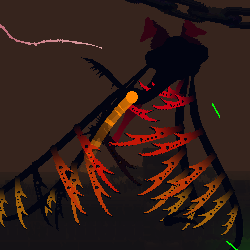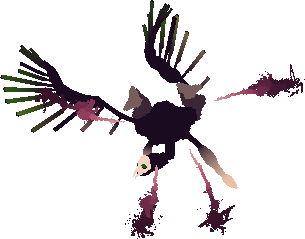
In Rainworld, any place always has danger associated with it, and the sky is no exception. The Vultures and Miros Birds are 2 families of birds that terrorize the vast majority of fauna in their ecosystem, either due to their large size or ferocious attacks, these creatures represent a great threat to anyone who is in their territory.
Neither of these 2 species has a natural origin, but is the result of some kind of experiment carried out by a previous civilization that has left with its departure 2 candidates for alpha predator of its ecosystem.
Vultures are large aerial predators, capable of diving into any room with an open ceiling. Characterized by their skull-like masks and large wings that expel pink gas, they present a persistent threat, appearing throughout many regions.
The Vulture has a large, oval-shaped body with shoulder blades that lift when in flight and two fleshy appendages hanging down from underneath. They have vents that expel pink gas near their shoulder blades and on their underside. Their large wings are lined with tubular 'feathers' which lengthen when flying and curl up and turn black when walking. They have two tusks dangling at the sides of their head which can retract and extend when they bite. Their face is covered by a mask, underneath which their eyes can be seen.
Despite their large size and health pool, Vultures often retreat after taking only 2-3 ![]() Spear hits. They typically require 9-11 Spear hits to kill.
Spear hits. They typically require 9-11 Spear hits to kill.
If intending to kill one, an efficient method is to stockpile a few Spears in an enclosed space, lure a Vulture there,and throw Spears in rapid succession. This stun-locks them so they are unable to escape. Move fast and circle around theVulture, using the environment to block them from getting a bite and spearing them when possible. Their head and necktake double damage, and hits to their wings deal almost no damage.
Vultures are able to watch from off-screen before diving in to chase their prey, making stealth ineffective when in open spaces. The player may avoid Vultures by retreating into tunnels or under cover where possible. Vultures are faster than Slugcat when flying, but slower when walking, making evading them a matter of deciding whether totry outrun them or circle around. Using their size and the terrain against them to force them to take longer routes canbuy valuable time. Retreating to another room and waiting for them to leave is a viable option; Vultures cannot movethrough pipes, and they typically stay near pipe entrances for a few moments before leaving. The player can monitorwhether or not the Vulture is in front of the pipe connection by how much it flashes white. Additionally, distractingVultures with other creatures can provide enough time to slip by.
Vultures have two modes of movement: flying and walking. When flying, Vultures move quickly through the air, homing in on their targets. Once they are close enough to solid ground or their prey has retreated into a more enclosed space, they release a large amount of gas and grab onto the nearest terrain, signaling a transition to 'walking' mode, which allows them to stiltedly move around on their wings. Wings can shift modes independently of each other. Vultures give chase into any space so long as they can physically fit into it.
It is possible to demask Vultures, either live or dead, by hitting them in the base of their head
Live Vultures that are demasked are attacked by other, masked Vultures, and attempt to hunt down the creature that demasked them.The target is always prioritized by the Vulture. Additionally, their Eats relationship with other creatures is reduced to 10%. While Vultures typically grab their prey without killing them, demasked Vultures always attempt to kill the creature that removed their mask. The maskless state persists across cycles, even when the region the individual is located in is no longer loaded.
A demasked Vulture is always aware of their mask's location and attempts to move to the room it is located in, so long as it is a room that they can access.
Vulture Masks can be picked up and used to ward off any ![]() Lizard within range (except for
Lizard within range (except for ![]() Black and
Black and ![]() Red Lizards) for 17. 5 seconds. This only works once per individual Lizard and only once per cycle. Vulture Masks are also useful for trading with
Red Lizards) for 17. 5 seconds. This only works once per individual Lizard and only once per cycle. Vulture Masks are also useful for trading with ![]() Scavengers.
Scavengers.
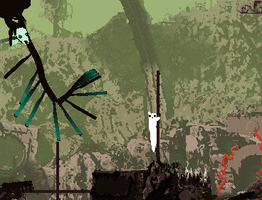
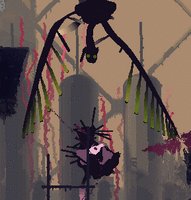
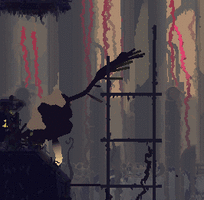
King Vultures are a more aggressive and dangerous variant of Vulture, characterized by their ability to fire harpoons at prey from afar.
King Vultures only spawn naturally as ![]() Hunter and in certain campaigns. While playing as
Hunter and in certain campaigns. While playing as ![]() Monk or
Monk or ![]() Survivor, they can be encountered via the lineage system.
Survivor, they can be encountered via the lineage system.
The King Vultures are significantly larger than standard Vultures and possess two large, striped harpoons on the sides of their heads in place of a standard Vulture's short tusks. The harpoons are connected to the base of their necks with ropes that reel them back in after being shot. Additionally, they have laser-sights emitting from their eyes, which can vary from pink to orange in color, and an upside-down triangle on the forehead of their masks. Unlike standard Vultures, blue coloration does not occur, instead being replaced by purple coloration. Some King Vultures may exhibit multiple colors on their wings.
King Vultures are are less likely to flee than Vultures are. They only attempt to retreat after taking a large amount of damage. It takes roughly 13+ ![]() Spear hits to kill them. King Vulture harpoons kill instantly upon contact. King Vultures can shoot harpoons at point blank range, which are near impossible to dodge. Their harpoons can not be parried with Spears or with
Spear hits to kill them. King Vulture harpoons kill instantly upon contact. King Vultures can shoot harpoons at point blank range, which are near impossible to dodge. Their harpoons can not be parried with Spears or with ![]() Artificer's concussive blast. King Vultures attempt to bite their prey after they have fired both harpoons, with a short window before they attempt to fire again. King Vultures can be lured under geometry they are unable to escape from and be stunlocked with two Spears. An
Artificer's concussive blast. King Vultures attempt to bite their prey after they have fired both harpoons, with a short window before they attempt to fire again. King Vultures can be lured under geometry they are unable to escape from and be stunlocked with two Spears. An ![]() Explosive Spear can incapacitate a King Vulture.
Explosive Spear can incapacitate a King Vulture.
When King Vultures lose sight of their prey, their harpoon windup is cancelled and they must re-attempt a fire. While passing under geometry stops their windup, King Vultures may follow the player beneath geometry, or into a location where their windup can not be interrupted. Their harpoons can be dodged by use of movement like dash-turns and slides. King Vultures lose interest when they can not see any prey and leave the room after a short duration. The player can hide in pipes, under geometry King Vultures can not reach, or another room until a King Vulture leaves.
King Vultures are behaviorally identical to standard Vultures aside from their harpoons and ability to hunt ![]() Green Lizards. King Vulture Masks scare all Lizards except
Green Lizards. King Vulture Masks scare all Lizards except ![]() Red Lizards and
Red Lizards and ![]() Black Lizards for 30 seconds.
Black Lizards for 30 seconds.
King Vultures are capable of shooting their head-mounted harpoons at prey. Harpoons are shot individually and require a short amount of time to wind up, during which the laser-sight corresponding to the harpoon being shot blinks white and makes a pinging noise 3 times before it is fired. They stop winding up if they lose direct line of sight of their target. Harpoons can kill most smaller creatures, and often incapacitate those that survive the initial shot. If a harpoon hits the terrain, it may get stuck for a while, restricting the King Vulture's movement. If a harpoon impales a creature of lesser body mass, it is dragged along by the King Vulture’s movement. Once shot, harpoons have to be reeled back in before they can be used again. King Vultures often move into closer range and attempt to bite at prey while they are on cooldown.
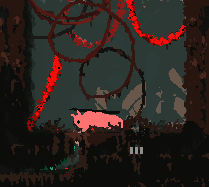
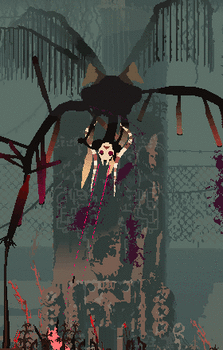
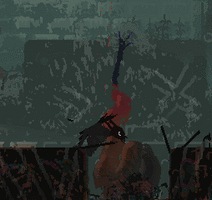
Miros Birds, also known as Scissor Birds, are fast, dangerous creatures found throughout ![]() Shaded Citadel Memory Crypts and in some longer rooms of
Shaded Citadel Memory Crypts and in some longer rooms of ![]() Subterranean and
Subterranean and ![]() Metropolis.
Metropolis.
Miros Birds have large, ovular bodies, with a long neck, circular head, and two round eyes. Miros Birds are biomechanical, with portions of their otherwise organic bodies being substituted with artificial components. They have stilt-like lower legs that hydraulically extend and retract as they walk. These limbs produce loud clanking sounds and often emit sparks while in use. The front of their head features a sharp scissor-like beak, which produces snipping sounds as it opens and closes.
While Miros Birds can be killed, their high health and bite lethality make attempts at normal combat risky. Miros Birds are quick to bite anything that gets too close, which makes engaging at close quarters challenging without first stunning, blinding, or distracting them. Miros Birds can be reliably killed with a single ![]() Explosive Spear. The simplest way of killing a Miros Bird when an Explosive Spear is not available is to isolate one from the group, blind it with a
Explosive Spear. The simplest way of killing a Miros Bird when an Explosive Spear is not available is to isolate one from the group, blind it with a ![]() Flashbang, and then Spear it to death. This still requires caution as Miros Birds may bite
Flashbang, and then Spear it to death. This still requires caution as Miros Birds may bite ![]() Slugcat even when blinded.
Slugcat even when blinded. ![]() Jellyfish can also be used to temporarily incapacitate them while doing damage.
Jellyfish can also be used to temporarily incapacitate them while doing damage.
Throwing a ![]() Flashbang directly at a Miros Bird blinds it for 10 seconds. This duration decreases linearly with distance, from 10s at 3 tiles or less to 0.5s at a distance of 30 tiles, up to 80 tiles if seen. Blindness does not stack; for new Flashbang detonations, the longest duration between the current and new blind is used. Miros Birds' eyes flash in rainbow colors when blinded.
Flashbang directly at a Miros Bird blinds it for 10 seconds. This duration decreases linearly with distance, from 10s at 3 tiles or less to 0.5s at a distance of 30 tiles, up to 80 tiles if seen. Blindness does not stack; for new Flashbang detonations, the longest duration between the current and new blind is used. Miros Birds' eyes flash in rainbow colors when blinded.
Miros Birds are found in long, horizontal rooms, where they run from side to side, attacking any prey they come across. They are most often found in groups of 3-5, mainly due to their spawning from the same off-screen dens. Miros Birds antagonize other Miros Birds; they can often be seen aggressively snapping at each other.
Miros Birds cannot hear but have excellent sight that allows them to spot creatures from over a screen away. This trait also makes them vulnerable to Flashbangs, which temporarily blind them when thrown. Blinded Miros Birds stay stationary and frantically snap their beak around in an attempt to bite nearby creatures.
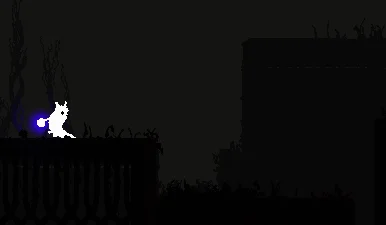
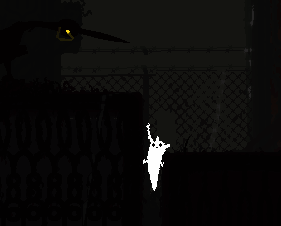
Miros Vultures are large, aerial predators exclusive to the More Slugcats Expansion. They are highly aggressive and are capable of using an explosive laser in self-defense. They resemble a combination between the Miros Bird and the Vulture.
The Miros Vulture has the head shape, glowing eyes, and long, scissor-like beak of a Miros Bird as well as the large wings, shoulder humps, and pink gas expulsion of a Vulture. They have 2 pairs of wings, more slender than those of a standard Vulture's, each bearing many sharp blade-like 'feathers'. Each wing appears to be hooked at the tip. When charging up their laser, the color of their feathers flickers rapidly.
Given their large health pool, ![]() Explosive Spears are highly recommended when attempting to fight a Miros Vulture. Evading their constant snapping is difficult when fighting in open areas; access to tunnels or cover narrow enough to hide in are crucial when the Miros Vulture swoops close to the ground. When injured, they open their mouth wide to retaliate by emitting a laser beam from their mouth that slowly charges up a powerful explosion, shooting where the laser beam is directed. Miros Vultures are highly resistant to their own explosions. To avoid the explosion, the player should move away and hide in a space where the Miros Vulture cannot follow or outside of the explosion radius; after using this ability, they resume their default attack. The explosion attack has a long wind-up, allowing for a few quick hits before taking cover. It takes about 4
Explosive Spears are highly recommended when attempting to fight a Miros Vulture. Evading their constant snapping is difficult when fighting in open areas; access to tunnels or cover narrow enough to hide in are crucial when the Miros Vulture swoops close to the ground. When injured, they open their mouth wide to retaliate by emitting a laser beam from their mouth that slowly charges up a powerful explosion, shooting where the laser beam is directed. Miros Vultures are highly resistant to their own explosions. To avoid the explosion, the player should move away and hide in a space where the Miros Vulture cannot follow or outside of the explosion radius; after using this ability, they resume their default attack. The explosion attack has a long wind-up, allowing for a few quick hits before taking cover. It takes about 4 ![]() Explosive Spears to the head to kill a Miros Vulture. In areas such as
Explosive Spears to the head to kill a Miros Vulture. In areas such as ![]() The Exterior, Miros Vultures can be baited to enter small pipes headfirst, allowing Slugcat to spear them in the head and retrieve the Spears relatively safely.
The Exterior, Miros Vultures can be baited to enter small pipes headfirst, allowing Slugcat to spear them in the head and retrieve the Spears relatively safely.
Evading Miros Vultures is difficult due to their speed and persistence. The only effective distraction is the use of a Flashbang, which temporarily blinds them; however, ![]() Flashbangs are rare in most areas that Miros Vultures frequent. The Miros Vulture is also unpredictable, stopping in one spot only to go a completely different way. A use of Explosive Jumping is required in Evasion in large spaces.
Flashbangs are rare in most areas that Miros Vultures frequent. The Miros Vulture is also unpredictable, stopping in one spot only to go a completely different way. A use of Explosive Jumping is required in Evasion in large spaces.
When spotted, escaping to the nearest pipes or tunnels and making use of Sliding and Explosive Jumping is advised.Miros Vultures are very persistent, often remaining at the spot they last saw Slugcat.
Miros Vultures are capable of using a hitscan explosive laser blast, which they use in retaliation when injured. When used, a telegraphing laser shines out of their eye, emitting a sound similar to a ![]() Vulture Grub laser. The laser slowly turns from yellow to red, and the light on the ground where the laser hits also shrinks. Eventually, an explosion occurs at the point the laser touches.
Vulture Grub laser. The laser slowly turns from yellow to red, and the light on the ground where the laser hits also shrinks. Eventually, an explosion occurs at the point the laser touches.
Miros Vultures are capable of moving swiftly both on land and through the air. Unlike regular Vultures, they can pursue their prey even through narrow spaces. This means that hiding inside a tunnel is not always sufficient to escape a Miros Vulture.
